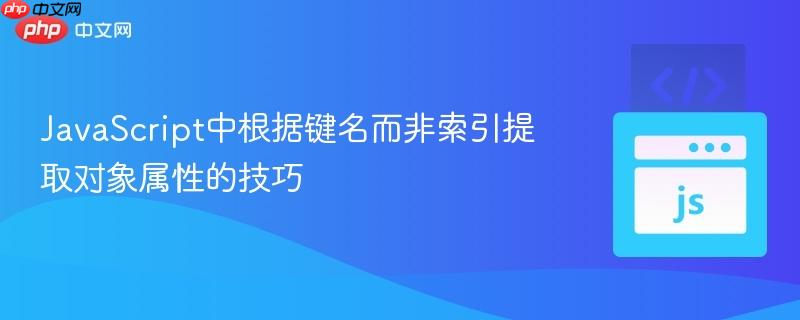
本文旨在解决javascript中从对象数组中提取特定属性时,避免依赖属性索引的脆弱性问题。我们将探讨如何利用点表示法、方括号表示法以及对象解构等现代javascript特性,结合array.prototype.map方法,以健壮且高效的方式根据键名准确地筛选和重构数据,确保代码在属性顺序变化时依然稳定运行。
在JavaScript开发中,我们经常需要处理包含多个对象的数组,并从中提取或转换数据。一个常见的场景是,我们有一个包含多余属性的对象数组,需要将其转换为一个只包含特定关键属性的新对象数组。初学者在处理这类问题时,可能会尝试使用Object.values()结合索引来获取属性值,但这是一种不推荐的做法,因为它高度依赖于对象属性的定义顺序,一旦属性顺序发生变化,代码就会失效。
考虑以下原始数据结构:
const items = [
{
product: 'prodOne',
quantity: 3,
sending: 100,
receiving: 50
},
{
product: 'prodTwo',
quantity: 4,
sending: 50,
receiving: 100
},
{
product: 'prodThree',
quantity: 8,
sending: 100,
receiving: 100
}
];目标是将其转换为只包含 product 和 quantity 属性的新数组:
const itemsRed = [
{
product: 'prodOne',
quantity: 3,
},
{
product: 'prodTwo',
quantity: 4,
},
{
product: 'prodThree',
quantity: 8,
}
];如果尝试使用 Object.values() 并通过索引访问,例如:
立即学习“Java免费学习笔记(深入)”;
const x = items.map(function (obj){
var prod = Object.values(obj)[0] // 依赖于 'product' 是第一个属性
var qty = Object.values(obj)[1] // 依赖于 'quantity' 是第二个属性
return {product: prod, quantity: qty}
});这种方法存在严重缺陷。JavaScript对象的属性在ES2015之前并没有严格的顺序保证(尽管现代引擎通常会保留插入顺序),即使保留了顺序,一旦原始对象中属性的定义顺序发生改变,上述代码就会立即失效,导致提取到错误的数据。
为了解决这个问题,我们应该直接通过属性的键名(key)来访问其值。JavaScript提供了多种健壮的方式来实现这一点。
这是最直观和常用的方法,通过 object.propertyName 的形式来访问属性。
const resultDotNotation = items.map(function(obj) {
const prod = obj.product; // 直接通过键名 'product' 访问
const qty = obj.quantity; // 直接通过键名 'quantity' 访问
return {
product: prod,
quantity: qty
};
});
console.log("使用点表示法:", resultDotNotation);当属性名包含特殊字符(如空格、连字符)或者属性名是动态生成时,可以使用方括号表示法 object['propertyName']。在本例中,虽然点表示法更简洁,但方括号表示法同样有效。
const resultBracketNotation = items.map(function(obj) {
const prod = obj['product']; // 直接通过键名 'product' 访问
const qty = obj['quantity']; // 直接通过键名 'quantity' 访问
return {
product: prod,
quantity: qty
};
});
console.log("使用方括号表示法:", resultBracketNotation);ES6引入的对象解构语法提供了一种更简洁、更强大的方式来从对象中提取属性。这在Array.prototype.map回调函数中尤其有用。
const resultDestructuring = items.map(({ product, quantity }) => ({ product, quantity }));
console.log("使用对象解构:", resultDestructuring);代码解析:
下面是一个包含所有方法的完整示例,展示了它们的输出结果:
const items = [
{
product: 'prodOne',
quantity: 3,
sending: 100,
receiving: 50
},
{
product: 'prodTwo',
quantity: 4,
sending: 50,
receiving: 100
},
{
product: 'prodThree',
quantity: 8,
sending: 100,
receiving: 100
}
];
// 1. 使用点表示法
const resultDotNotation = items.map(function(obj) {
const prod = obj.product;
const qty = obj.quantity;
return {
product: prod,
quantity: qty
};
});
console.log("--- 使用点表示法 ---");
console.log(resultDotNotation);
// 2. 使用方括号表示法
const resultBracketNotation = items.map((item) => ({
product: item['product'],
quantity: item['quantity']
}));
console.log("\n--- 使用方括号表示法 ---");
console.log(resultBracketNotation);
// 3. 使用对象解构 (最推荐)
const resultDestructuring = items.map(({ product, quantity }) => ({ product, quantity }));
console.log("\n--- 使用对象解构 ---");
console.log(resultDestructuring);
// 验证所有方法输出结果一致
console.log("\n--- 验证结果一致性 ---");
console.log(JSON.stringify(resultDotNotation) === JSON.stringify(resultDestructuring)); // true综上所述,当需要从JavaScript对象中提取特定属性时,应始终通过属性的键名进行访问,而非依赖于其在对象中的索引位置。对象解构结合Array.prototype.map提供了一种优雅、高效且健壮的解决方案,是处理此类数据转换任务的首选方法。
以上就是JavaScript中根据键名而非索引提取对象属性的技巧的详细内容,更多请关注php中文网其它相关文章!

每个人都需要一台速度更快、更稳定的 PC。随着时间的推移,垃圾文件、旧注册表数据和不必要的后台进程会占用资源并降低性能。幸运的是,许多工具可以让 Windows 保持平稳运行。

Copyright 2014-2025 https://www.php.cn/ All Rights Reserved | php.cn | 湘ICP备2023035733号